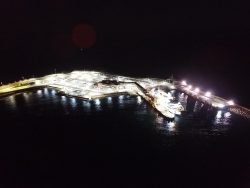A record 24 stranded Scopoli’s Shearwaters have been recovered by members of the public this year, five more than in 2017, showing the worrying effects of increasing levels of light pollution across the Maltese Islands.

A young Scopoli’s Shearwater fledgling about to fly back to sea after it was rescued by members of the public who found it disoriented by bright lights in an urban area
These stranded birds are fledglings, young birds that have left the nest on their maiden flight and become disoriented by bright lights from coastal developments and towns, resulting in them becoming stranded on land. This year, most stranded shearwaters were found at Ħal Far and the Freeport in Malta, and Victoria and Xlendi in Gozo – areas with high levels of light pollution.
This trend was also seen in the record numbers of stranded Yelkouan Shearwaters earlier in the year. Grounded shearwaters are extremely vulnerable to predation, collision with vehicles, and dehydration, making light-induced strandings a leading cause of mortality for young shearwaters worldwide.
A change in our nocturnal environment has seen shearwater strandings increase dramatically in recent years. The current period of rapid urbanisation and development that Malta is currently undergoing is likely the major contributing factor to this deteriorating situation. However, thanks to an increase in public awareness generated through LIFE Arċipelagu Garnija about stranded shearwaters, more birds have been rescued and safely released.

Coastal light pollution arising from excessively bright LEDs and inefficient directing of light is the main cause of young shearwaters becoming stranded on land
Light pollution occurs as a result of poorly installed lights, excessive illumination of structures and inefficient directing of light. Once famed for its pristine night skies, Malta is now the 17th worst light-polluted country on Earth relative to population size. According to the recently revised Atlas of Artificial Night-Sky Brightness, the Milky Way is visible from only 11% of the country. Levels of light pollution are expected to increase as new developments opt for more energy efficient white-light LEDs which cause up to twice as much light pollution as the yellow-light of traditional outdoor lighting. Scientific studies have identified light pollution as a fast-growing threat to global ecosystems as artificial light at night disrupts the normal behaviours of plants and animals.
24 stranded Scopoli’s Shearwaters have been recovered and successfully released back to sea in 2018 thanks to the public response

Clear contrast in glare and light pollution emitted by LEDs and conventional high-pressure sodium lamps as seen in Buġibba
BirdLife Malta’s LIFE Arċipelagu Garnija project is continuing to work towards mitigating the impacts of light pollution. On the 22nd November, the project will be co-hosting a light pollution workshop with ADŻ Green Youth Malta and the Light Pollution Awareness Group at Salina Nature Reserve to inform local councils, business owners and various associations on the dangers of light pollution with a focus on Malta’s seabirds. BirdLife Malta is encouraged by the goodwill of Transport Malta that have joined efforts as partners in this project.
If you are interested in attending the “Shining a light on Pollution” workshop, please contact Project Warden Martin Austad on [email protected] to reserve your place.
BirdLife Malta would like to thank the officers of the Administrative Law Enforcement (ALE) unit of the Malta Police Force and all members of the public involved in recovering stranded shearwaters. All recovered birds were successfully released back to sea again.
Read the Maltese version of the press release here.
